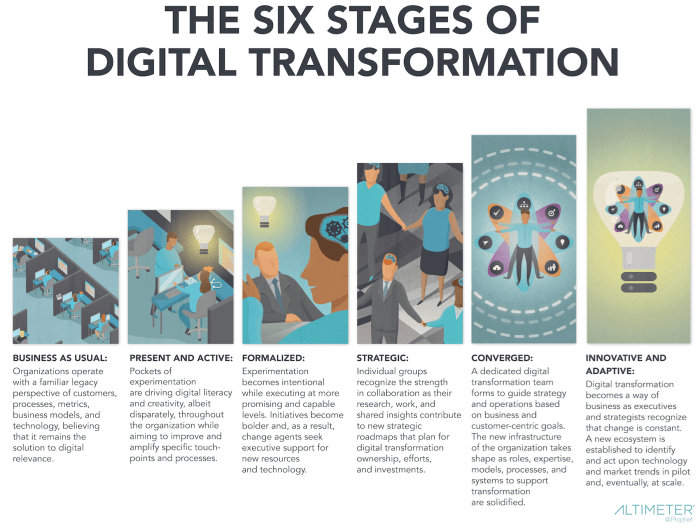
Embark on a journey into the realm of digilife digital transformation case studies, where businesses evolve through technology and innovation. Discover how companies navigate the digital landscape to stay ahead in the market, showcasing their successful transformation stories.
Delve deeper into the key aspects of digital transformation, from its definition and importance to real-world examples of companies that have thrived in the digital era.
Overview of Digilife Digital Transformation Case Studies

Digital transformation in business refers to the integration of digital technology into all areas of a company, fundamentally changing how it operates and delivers value to customers. This includes utilizing technologies such as cloud computing, data analytics, artificial intelligence, and automation to improve processes, enhance customer experiences, and drive innovation.
Case studies play a crucial role in understanding digital transformation as they provide real-world examples of companies that have successfully navigated the complexities of digital change. These studies offer insights into the strategies, challenges, and outcomes of digital transformation initiatives, serving as valuable resources for organizations looking to embark on similar journeys.
Examples of Successful Digital Transformation
- Amazon: The e-commerce giant transformed from an online bookstore into a global marketplace offering a wide range of products and services. Through innovations like one-click shopping, personalized recommendations, and Prime membership, Amazon has revolutionized the retail industry.
- Netflix: Originally a DVD rental service, Netflix transitioned to a streaming platform, disrupting the traditional TV industry. By leveraging data analytics to personalize content recommendations and producing original series and movies, Netflix has become a leader in the entertainment sector.
- McDonald’s: The fast-food chain embraced digital technologies to enhance customer experiences and streamline operations. Initiatives such as self-service kiosks, mobile ordering, and delivery services have modernized McDonald’s and increased customer satisfaction.
Factors Driving Digital Transformation in Business
In today’s rapidly evolving business landscape, several key factors are driving companies towards digital transformation.
Role of Technology in Enabling Digital Transformation
Technology plays a crucial role in enabling digital transformation by providing the tools and platforms necessary to streamline processes, improve efficiency, and enhance customer experiences.
- Cloud Computing: The adoption of cloud computing allows businesses to scale operations, reduce costs, and access data from anywhere, facilitating digital transformation initiatives.
- Artificial Intelligence: AI technologies help automate tasks, analyze data, and personalize customer interactions, driving innovation and competitiveness.
- Internet of Things (IoT): IoT devices enable the collection of real-time data, leading to smarter decision-making, predictive maintenance, and enhanced operational efficiency.
Impact of Customer Demands on Digital Transformation
Customer demands play a significant role in shaping the need for digital transformation, as businesses strive to meet evolving expectations and deliver seamless experiences.
- Personalization: Customers expect personalized products, services, and interactions, prompting companies to leverage data and technology for tailored experiences.
- Convenience: The demand for convenience has led to the rise of digital platforms and mobile solutions that offer easy access to products and services.
- Speed: With the emphasis on speed and responsiveness, businesses are adopting digital tools to streamline processes and deliver rapid solutions to customer queries and requests.
Challenges Faced During Digital Transformation
Implementing digital transformation in businesses comes with its own set of challenges that can hinder the process. These challenges need to be identified and addressed effectively to ensure a successful transformation.
Common Obstacles During Digital Transformation
During the digital transformation journey, companies often encounter the following challenges:
- Lack of clear strategy and vision for digital transformation.
- Resistance to change from employees and stakeholders.
- Legacy systems and outdated technology infrastructure.
- Data privacy and security concerns.
- Siloed organizational structure hindering collaboration.
Overcoming Resistance to Change
To overcome resistance to change during digital transformation, organizations can:
- Communicate the benefits of digital transformation clearly to all stakeholders.
- Provide adequate training and support to employees to adapt to new technologies.
- Involve employees in the decision-making process to gain buy-in.
- Lead by example with strong leadership advocating for change.
Examples of Failed Digital Transformation Attempts
Several companies have faced challenges and failures in their digital transformation efforts:
- Blockbuster: Failed to adapt to the shift to digital streaming and online rentals, leading to bankruptcy.
- Kodak: Missed the opportunity to embrace digital photography, despite inventing the digital camera, resulting in a decline in market share.
- Nokia: Lost its dominance in the mobile phone market due to a slow response to the rise of smartphones.
Successful Strategies and Best Practices in Digital Transformation

Implementing successful digital transformation requires the adoption of effective strategies and best practices. These strategies play a crucial role in ensuring the smooth transition towards a digital-centric business model.
Importance of Leadership in Driving Digital Transformation Initiatives
Strong leadership is essential in driving digital transformation initiatives within an organization. Leaders need to champion the digital transformation process, set clear objectives, and provide the necessary resources and support to make it successful. They should also inspire and motivate employees to embrace change and adapt to new technologies.
Real-World Examples of Companies Excelling in Digital Transformation
- Amazon: Amazon has revolutionized the retail industry with its digital transformation initiatives, focusing on enhancing customer experience through personalized recommendations, streamlined logistics, and efficient order processing.
- Netflix: Netflix disrupted the entertainment industry by leveraging digital technologies to deliver content directly to consumers, offering a personalized and convenient viewing experience that has reshaped how people consume media.
- Salesforce: Salesforce has excelled in digital transformation by providing cloud-based CRM solutions that empower organizations to connect with customers, streamline sales processes, and drive business growth through data-driven insights.
Final Wrap-Up

In conclusion, digilife digital transformation case studies shed light on the dynamic nature of businesses adapting to the digital age. Uncovering the challenges, strategies, and successes within this realm offers valuable insights for companies aiming to thrive in an ever-evolving market.
Clarifying Questions
What is digital transformation?
Digital transformation refers to the integration of digital technology in all aspects of a business, fundamentally changing how it operates and delivers value to customers.
How does technology enable digital transformation?
Technology acts as the catalyst for digital transformation by providing tools and platforms that streamline processes, enhance customer experiences, and drive innovation.
What are common obstacles during digital transformation?
Common challenges include resistance to change, lack of digital skills, inadequate resources, and legacy systems that hinder the transformation process.
Why is leadership crucial in driving digital transformation initiatives?
Leadership plays a vital role in setting the vision, guiding the team through change, and fostering a culture of innovation and adaptability essential for successful digital transformation.














